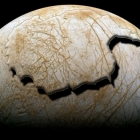Getting Under Europa's Skin
Europa is one of the most enticing targets in the search for life beyond Earth. With an icy outer shell hiding a global ocean, Europa exists in a dynamic environment, where immense tides from Jupiter potentially power an active deeper interior. Intense irradiation and impacts bathe the top of the ice shell. These processes are sources of energy that could sustain a biosphere. Why is all of this important? It’s simple: the search for extant life is more complicated than the search for water or an oxygen atmosphere. Earth’s biosphere is strongly coupled to geologic activity—plate tectonics, weathering, glaciation; geologic processes are crucial to this living planet.
In the past few decades the debate about habitability of Europa has been focused strongly on the thickness of its ice shell. However an arguably more critical question is: how does the ice shell really work? The detection of plate tectonics on Europa, as well as burgeoning evidence for shallow subsurface water implies that rapid ice shell recycling could create a conveyor belt between the ice and ocean. Exchange between Europa's surface and subsurface could allow ocean material to one day be detected by spacecraft and will be mediated by melting, accretion, and redistribution at the base of the ice shell, processes not well understood even on Earth. And while microbial life within ice and below glaciers has been studied for decades, one of the most relevant terrestrial analog environments, the ice-ocean interface beneath ice shelves, has remained largely uncharacterized…until now.
In this presentation, we will explore environments on Europa and their analogs on Earth. While we wait for the opportunity to send a new mission to Europa, looking to our own cosmic backyard, Antarctica, allows us to better understand Europa’s habitability and to develop techniques to explore this ice covered world not so unlike our own.

